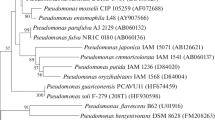Abstract
Crude cell extracts of Pseudomonas putida F6 transformed 4-substituted fluoro-, chloro-, bromo- and iodo-phenol without the exogenous addition of cofactors. The rate of substrate consumption decreased with increasing substituent size (F>Cl>Br>I). Biotransformations resulted in greater than 95% utilisation of the halogenated substrate. Product accumulation was observed in incubations with 4-chloro, 4-bromo- and 4-iodo-phenol. These products were identified as the corresponding 4-substituted catechols. Transformation of 4-fluorophenol did not result in the accumulation of the corresponding catechol; however, manipulation of the reaction conditions by incorporation of ascorbic acid culminated in the formation of 4-fluorocatechol. Cell extracts of P. putida F6 also showed activity towards a 3-substituted phenol, namely 3-fluorophenol, resulting in the formation of a single product, 4-fluorocatechol.





Similar content being viewed by others
References
Boersma MG, Dinarieva TY, Middelhoven WJ, VanBerkel WJH., Doran J, Vervoort J, Rietjens IMCM (1998) 19F Nuclear magnetic resonance as a tool to investigate microbial degradation of fluorophenols to fluorocatechols and fluoromuconates. Appl Environ Microbiol 64:1256–1263
Cabanes J, Garcia-Canovas F, Garcia-Carmona, F. (1994) Chemical and enzymatic oxidation of 4-methylcatechol in the presence and absence of l-serine. Spectrophotometric determination of intermediates. Biochim Biophys Acta 917:190–197
Davis FA, Srirajan V, Titus DD (1999) Efficient asymmetric synthesis of β-fluoro α-amino acids. J Org Chem 64:6931–6934
Espin JC, Wichers HJ (1999) Kinetics of activation of latent mushroom (Agaricus bisporus) tyrosinase by benzyl alcohol. J Agric Food Chem 47:3503–3508
Espin JC, Morales M, Garcia-Ruiz PA, Tudela J, Garcia-Canovas F (1997a) Improvement of a continuous spectrophotometric method for determining the monophenolase and diphenolase activities for mushroom polyphenol oxidase. J Agric Food Chem 45:1084–1090
Espin JC, Trujano MF, Tudela J, Garcia-Canovas F (1997b) Monophenolase activity of polyphenol oxidase from Haas avocado. J Agric Food Chem 45:1091–1096
Espin JC, Soler-Rivas C, Cantos E, Tomas-Barberan FA, Wichers HJ (2001) Synthesis of the antioxidant hydroxytyrosol using tyrosinase as biocatalyst. J Agric Food Chem 49:1187–1193
Finkelstein ZI, Baskunov BP, Boersma MG, Vervoort J, Golovlev EL, Van Berkel W J, Golovleva LA, Rietjens IMCM (2000) Identification of fluoropyrogallols as new intermediates in biotransformation of monofluorophenol in Rhodococcus opacus 1cp. Appl Environ Microbiol 66:2148–2153
Golan-Goldhirsh A, Whitaker JR (1984) Effect of ascorbic acid, sodium bisulphite, and thiol compounds on mushroom polyphenol oxidase. J Agric Food Chem 32:1003–1009
Haggblom MM (1992) Microbial breakdown of halogenated aromatic pesticides and related compounds. FEMS Microbiol Rev 103:29–72
Haggblom MM, Valo RJ (1995) Biodegradation of chlorophenol wastes. In: Young LY, Cerniglia CT (eds) Microbial transformation and degradation of toxic organic chemicals. Wiley-Liss New York, pp 389-434
Held M, Suske W, Schmid A, Engesser K-H, Kohler H-PE, Wubbolts MG (1998) Preparative scale production of 3-substituted catechols using a novel monooxygenase from Pseudomonas azelaica HBP-1. J Mol Catal B: Enzymatic. 5:87–93
Kirk KL, Creveling CR (1984) The chemistry and biology of ring-fluorinated biogenic amines. Med Res Rev 4:189–220
Kojima Y, Tsukuda Y, Kawai Y, Tsukamoto A, Suguira J, Sakaino M, Kita Y (1990) Cloning, sequence analysis, and expression of ligninolytic phenoloxidase genes of the white-rot basidiomycete Coriolus hirsutus. J Biol Chem 265:15224–15233
Kong KH, Hong MP, Choi S, Kim KYT, Cho SH (2000) Purification and characterization of a highly stable tyrosinase from Thermomicrobium roseum. Biotechnol Appl Biochem 31:113–118
Lowry OH, Roseburgh N, Farr AL, Randall R (1951) Protein measurement with the phenol reagent. J Biol Chem 193:265–275
Marr J, Kremer S, Sterner O, Anke H (1996) Transformation and mineralization of halophenols by Penicillium simplicissimum SK9117. Biodegradation 7:165–171
Monserrate E, Haggblom MM (1997) Dehalogenation and biodegradation of brominated phenols and benzoic acids under iron-reducing, sulfidogenic, and methanogenic conditions. Appl Environ Microbiol 63:3911–3915
O’ Connor KE, Duetz W, Wind B, Dobson ADW (1996) The effect of nutrient limitation on styrene metabolism in Pseudomonas putida CA-3. Appl Environ Microbiol 62:3594–3599
O’ Connor KE, Witholt B, Duetz W (2001) p-Hydroxyphenylacetic acid metabolism in Pseudomonas putida F6. J Bacteriol 183:928–933
Peelen S, Rietjens IMCM, Boersma MG, Vervoort J (1995) Conversion of phenol derivatives to hydroxylated products by phenol hydroxylase from Trichosporon cutaneum. A comparison of regioselectivity and rate of conversion with calculated molecular orbital characteristics. Eur J Biochem 227:284–291
Pialis P, Saville BA (1998) Production of L-DOPA from tyrosinase immobilized on nylon 6,6: enzyme stability and scaleup. Enzyme Microb Technol 22:261–268
Reinscheid UM, Bauer MP, Mueller R (1997) Biotransformation of halophenols by a thermophillic Bacillus sp. Biodegradation 7:455–461
Ridder L, Brigianti F, Boersma MG, Boeren S, Vis EH, Scozzafava A, Veeger, C Rietjens IMCM (1998) Quantitative structure/activity relationship for the rate of conversion of C4-substituted catechol by catechol-1,2-dioxygenase from Pseudomonas putida (arvilla) C1. Eur J Biochem 257:92–100
Rodriquez-Lopez JN, Escribano J, Garcia-Canovas F (1994) A continuous spectrophotometric method for the determination of monophenolase activity of tyrosinase using 3- methyl-2-benzothiazolinone hydrazone. Anal Biochem 216:205–212
Sanchez-Ferrer A, Rodriguez-Lopez JN, Garcia-Canovas F, Garcia-Carmona F (1995) Tyrosinase: a comprehensive review of its mechanism. Biochim Biophys Acta 1247:1–11
Vogel HJ, Bonner DM. (1956) Acetylornithase of E. coli: Partial purification and some properties. J Biol Chem 218:97–106
Acknowledgements
We wish to thank Dr. Zhi Li and Dongliang Chang (Institute of Biotechnology, ETH, Zurich, Switzerland) for carrying out LC-MS analysis, and Dr. Mike Casey and Kevin Conway (Department of Chemistry, University College Dublin, Dublin, Ireland) for carrying out GC-MS analysis. This work was supported by grants from the Enterprise Ireland Research Scholarship Programme (BR/1999/043), the Irish Environmental Protection Agency Contributory Scholarship Programme (2001-CS-(17/26) and the Wellcome Trust (055637/Z/98).
Author information
Authors and Affiliations
Corresponding author
Rights and permissions
About this article
Cite this article
Brooks, S.J., Doyle, E.M., Hewage, C. et al. Biotransformation of halophenols using crude cell extracts of Pseudomonas putida F6. Appl Microbiol Biotechnol 64, 486–492 (2004). https://doi.org/10.1007/s00253-003-1488-z
Received:
Revised:
Published:
Issue Date:
DOI: https://doi.org/10.1007/s00253-003-1488-z




